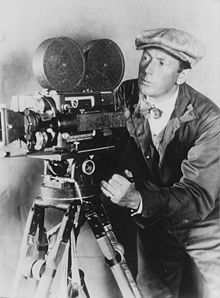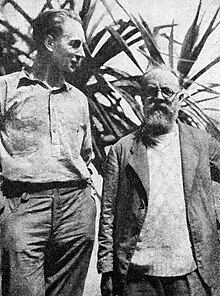F. W. Murnau
F. W. Murnau | |
|---|---|
 F.W. Murnau before 1931 | |
| Born | Friedrich Wilhelm Plumpe December 28, 1888 |
| Died | March 11, 1931 (aged 42) |
| Occupation | Film director |
| Years active | 1919—1931 |
| Height | 6'11 (2.10 m) |
Friedrich Wilhelm "F. W." Murnau (born Friedrich Wilhelm Plumpe; December 28, 1888 – March 11, 1931) was one of the most influential German film directors of the silent era, and a prominent figure in the expressionist movement in German cinema during the 1920s. Born in Bielefeld, Murnau had inspirations of Schopenhauer, Nietzsche, Shakesphere, and Ibsen plays he had seen at the age of 12, and made friends with director Max Reinhardt. Murnau also served as a company commander at the eastern front during World War I, surviving several crashes without any injuries.
Murnau's best known work was his 1922 film Nosferatu, an adaptation of Bram Stoker's Dracula. Although not a commercial success due to copyright issues with Stoker's novel, the film was a masterpiece of Expressionist artwork. He was also known for his work with the 1924 film The Last Laugh and his timeless, immaculate interpretation of Goethe's Faust (1926). He later emigrated to Hollywood in 1926, where he joined the Fox Studio and made three films, including Sunrise (1927), Four Devils (1928) and City Girl (1930).
Murnau travelled to Bora Bora to make the film Tabu in 1931 with documentary film pioneer Robert Flaherty, who left after artistic disputes with Murnau who had to finish the movie on his own. A week prior to the opening of the film Tabu, Murnau was killed in a car crash in Los Angeles, California.
Although some of Murnau's films have been lost, most still survive.
Early years
Although born in Bielefeld, Province of Westphalia, Murnau was raised in Kassel from the time he was seven.[1] He had two brothers, Bernhard and Robert, and two stepsisters, Ida and Anna. Murnau's mother Otilie Volbracht was the second wife of his father Heinrich Plumpe, the owner of a cloth-factory in the north-western part of Germany. Their villa was often turned into a stage for little plays, directed by Murnau, who already read books of Schopenhauer, Nietzsche, Shakespeare and Ibsen plays at the age of 12.[2][3] He took the name "Murnau" from the town in Germany named Murnau am Staffelsee. Openly gay, the 6'11 (210 cm) director was said to have an icy, imperious disposition and an obsession with film.[4]
Murnau studied philology at the University in Berlin and later art-history and literature in Heidelberg, where director Max Reinhardt saw him at a students' performance and decided to invite him to his actor-school. He soon became friends with Franz Marc, Else Lasker-Schüler and Hans Ehrenbaum-Degele. But after World War I broke out Murnau had to serve as a company commander at the eastern front.[2] Murnau joined the German air force in northern France two years later and survived eight crashes without severe injuries. He returned to his home country after an internment in Switzerland, where he won a prize for the best production-concept.
Career
After World War I ended, Murnau returned to Germany where he soon established his own film studio with actor Conrad Veidt. His first feature-length film, The Boy in Blue, a drama inspired by the famous Thomas Gainsborough painting, was released in 1919. He explored the popular theme of dual personalities, much like Robert Louis Stevenson's Dr. Jekyll and Mr. Hyde, in 1920's The Janus Head starring Veidt and Bela Lugosi.[5]

Murnau's most famous film is Nosferatu, a 1922 adaptation of Bram Stoker's Dracula for which Stoker's widow sued for copyright infringement. Murnau lost the lawsuit and all prints of the film were ordered to be destroyed, but bootleg prints survived. The vampire, played by German stage actor Max Schreck, resembled a rat which was known to carry the plague. The origins of the word are from Stoker's novel, where it is used by the Romanian townsfolk to refer to Count Dracula and presumably, other undead.
Nearly as important as Nosferatu in Murnau's filmography was The Last Laugh ("Der Letzte Mann", German "The Last Man") (1924), written by Carl Mayer (a very prominent figure of the Kammerspielfilm movement) and starring Emil Jannings. The film introduced the subjective point of view camera, where the camera "sees" from the eyes of a character and uses visual style to convey a character's psychological state. It also anticipated the cinéma vérité movement in its subject matter. The film also used the "Unchained Camera Technique", a mix of tracking shots, pans, tilts, and dolly moves. Also, unlike the majority of Murnau's other works, The Last Laugh is considered a Kammerspielfilm with Expressionist elements. Unlike expressionist films, Kammerspielfilme are categorized by their chamber play influence, involving a lack of intricate set designs and story lines / themes regarding social injustice towards the working classes.
Murnau's last German film was the big budget Faust (1926) with Gösta Ekman as the title character, Emil Jannings as Mephisto and Camilla Horn as Gretchen. Murnau's film draws on older traditions of the legendary tale of Faust as well as on Goethe's classic version. The film is well known for a sequence in which the giant, winged figure of Mephisto hovers over a town sowing the seeds of plague.
Nosferatu (music by Hans Erdmann) and Faust (music by Werner Richard Heymann) were two of the first films to feature original film scores.
Hollywood

Murnau emigrated to Hollywood in 1926, where he joined the Fox Studio and made Sunrise (1927), a movie often cited by film scholars as one of the greatest films of all time.[6] Filmed in the Fox Movietone sound-on-film system (music and sound effects only), Sunrise was not a financial success, but received several Oscars at the very first Academy Awards ceremony in 1929. In winning the Academy Award for Unique and Artistic Production it shared what is now the Best Picture award with the movie Wings.
Murnau's next two films, the (now lost) Four Devils (1928) and City Girl (1930), were modified to adapt to the new era of sound film and were not well received. Their poor receptions disillusioned Murnau, and he quit Fox to journey for a while in the South Pacific.[1]
Together with documentary film pioneer Robert Flaherty, Murnau travelled to Bora Bora to make the film Tabu in 1931. Flaherty left after artistic disputes with Murnau who had to finish the movie on his own. The movie was censored in the United States for images of bare-breasted Polynesian women.[citation needed] The film was originally shot by cinematographer Floyd Crosby as half-talkie, half-silent, before being fully restored as a silent film — Murnau's preferred medium.
Death


A week prior to the opening of the film Tabu, Murnau had driven up the coast from Los Angeles, California in a hired Rolls Royce.
The young and inexpert driver, who was a 14-year-old Philippine servant,[7] crashed the car against an electric pole. Murnau hit his head and died in a hospital shortly afterwards, in Santa Barbara,[1][8] and therefore did not live to see the premiere of his last film.
Murnau was entombed in Southwest Cemetery in Stahnsdorf (Südwest-Kirchhof Stahnsdorf) near Berlin. Only 11 people attended the funeral. Among them were Robert Flaherty, Emil Jannings, Greta Garbo and Fritz Lang, who delivered the funeral speech. Garbo also commissioned a death mask of Murnau, which she kept on her desk during her years in Hollywood.[9]
Derivative works
In 2000, director E. Elias Merhige released Shadow of the Vampire, a fictionalization of the making of Nosferatu. Murnau is portrayed by John Malkovich. In the film, Murnau is so dedicated to making the film genuine that he actually hires a real vampire (Willem Dafoe) to play Count Orlok.
Filmography
- Der Knabe in Blau (The Boy in Blue, released 28 June 1919)
- Satanas (released around 30 January 1920 but made in 1919)
- Der Bucklige und die Tänzerin (The Hunchback and the Dancer, released 8 July 1920)
- Der Janus-Kopf (Dr. Jekyll and Mr. Hyde / The Head of Janus, released 17 September 1920)
- Abend – Nacht – Morgen (Evening – Night – Morning, released October 1920)
- Sehnsucht (Desire: The Tragedy of a Dancer, released 18 October 1920)
- Der Gang in die Nacht (Journey Into the Night, released 13 December 1920)
- Schloß Vogelöd (The Haunted Castle / Castle Vogeloed, released April 1921)
- Marizza (released 20 January 1922 but filmed in 1921)
- Nosferatu, eine Symphonie des Grauens (Nosferatu, a Symphony of Horror, released 5 March 1922)
- Der brennende Acker (The Burning Soil, released 16 March 1922)
- Phantom (released 29 October 1922)
- Die Austreibung (The Expulsion, released 23 October 1923)
- Die Finanzen des Großherzogs (The Grand Duke's Finances, released 7 January 1924)
- Der letzte Mann (The Last Laugh, released 23 December 1924)
- Herr Tartüff (Tartuffe, released 25 January 1926)
- Faust (released 14 October 1926)
- Sunrise (released 23 September 1927, won a special Oscar for "Unique Artistic Presentation", the future award for Best Picture, at the first Academy Awards)
- 4 Devils (released 3 October 1928, is generally regarded as one of his best works and is a highly sought-after lost film)
- City Girl / Our Daily Bread (released 19 May 1930)
- Tabu (released 18 March 1931)
References
- ^ a b c "F.W. Murnau". TCM.
{{cite web}}: Text "50585/F-W-Murnau/" ignored (help) - ^ a b "Friedrich Wilhelm Murnau". internettrash.com. Archived from March 24, 2005.
- ^ [1]
- ^ F.W. Murnau. Eisner, Lotte H. (1964). Le Terrain Vague. ASIN: B0029LAF1M
- ^ "F. W. Murnau Biography". Biography.com. p. 1. Retrieved June 19, 2012.
- ^ http://us.share.geocities.com/toddmagos/polls22.htm[dead link] MASTER LIST][dead link] at us.share.geocities.com
- ^ Friederich Wilhelm Murnau. Nosferatumovie.com. Accessed from August 8, 2012.
- ^ "F. W. Murnau Killed in Coast Auto Crash". New York Times. March 12, 1931. Retrieved 2009-01-22.
Movie Director Planned to Go Home to Germany After Making South Seas Film. F.W. Murnau, German and American moving picture director, died this morning in a local hospital from injuries received in an automobile accident yesterday afternoon on the Coast Highway north of here.
{{cite news}}: Cite has empty unknown parameter:|coauthors=(help) - ^ Eisner, Lotte H. (1973). Murnau. University of California Press. p. 222. ISBN 978-0-520-02425-0.
{{cite book}}:|access-date=requires|url=(help)
External links
- Friedrich-Wilhelm-Murnau-Foundation, the legal successor to UFA, Bavaria, Terra, Tobis, and Berlin-Film
- F. W. Murnau at AllMovie
- F. W. Murnau at IMDb
- F.W. Murnau at filmportal.de
- F. W. Murnau at Find a Grave
- 1888 births
- 1931 deaths
- German film directors
- German-language film directors
- Horror film directors
- German emigrants to the United States
- German military personnel of World War I
- LGBT directors
- LGBT people from Germany
- People from Bielefeld
- People from the Province of Westphalia
- Road accident deaths in California
- Luftstreitkräfte personnel
- Silent films by director
